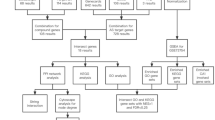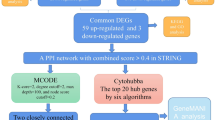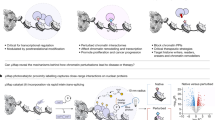Abstract
Despite several therapies being currently available to treat inflammatory diseases, new drugs to treat chronic conditions with less side effects and lower production costs are still needed. An innovative approach to drug discovery, the Connectivity Map (CMap), shows how integrating genome-wide gene expression data of drugs and diseases can accelerate this process. Comparison of genome-wide gene expression data generated with annexin A1 (AnxA1) with the CMap revealed significant alignment with gene profiles elicited by histone deacetylase inhibitors (HDACIs), what made us to hypothesize that AnxA1 might mediate the anti-inflammatory actions of HDACIs. Addition of HDACIs (valproic acid, sodium butyrate and thricostatin A) to mouse macrophages caused externalization of AnxA1 with concomitant inhibition of cytokine gene expression and release, events that occurred independently as this inhibition was retained in AnxA1 null macrophages. In contrast, novel AnxA1-mediated functions for HDACIs could be unveiled, including promotion of neutrophil apoptosis and macrophage phagocytosis, both steps crucial for effective resolution of inflammation. In a model of acute resolving inflammation, administration of valproic acid and sodium butyrate to mice at the peak of disease accelerated resolution processes in wild type, but much more modestly in AnxA1 null mice. Deeper analyses revealed a role for endogenous AnxA1 in the induction of neutrophil death in vivo by HDACIs. In summary, interrogation of the CMap revealed an unexpected association between HDACIs and AnxA1 that translated in mechanistic findings with particular impact on the processes that regulate the resolution of inflammation. We propose non-genomic modulation of AnxA1 in immune cells as a novel mechanism of action for HDACIs, which may underlie their reported efficacy in models of chronic inflammatory pathologies.
Similar content being viewed by others
Log in or create a free account to read this content
Gain free access to this article, as well as selected content from this journal and more on nature.com
or
Abbreviations
- AnxA1:
-
Annexin A1
- AnxAV:
-
annexin A5
- CMap:
-
connectivity map
- FPR:
-
formyl peptide receptors
- FPR2/ALX:
-
formyl peptide receptor type 2/lipoxin A4 receptor
- HDACI:
-
histone deacetylase inhibitor
- NSAID:
-
non-steroidal anti-inflammatory drug
- PKC:
-
protein kinase C
- PP2A:
-
protein phosphatase 2
- SB:
-
sodium butyrate
- TSA:
-
trichostatin A
- VPA:
-
valproic acid
- WT:
-
wild type
References
Medzhitov R . Origin and physiological roles of inflammation. Nature 2008; 454: 428–435.
Nathan C, Ding A . Nonresolving inflammation. Cell 2010; 140: 871–882.
Dransfield I, Rossi AG, Brown SB, Hart SP . Neutrophils: dead or effete? Cell surface phenotype and implications for phagocytic clearance. Cell Death and Differ 2005; 12: 1363–1367.
Savill J, Fadok V . Corpse clearance defines the meaning of cell death. Nature 2000; 407: 784–788.
Hallett JM, Leitch AE, Riley NA, Duffin R, Haslett C, Rossi AG . Novel pharmacological strategies for driving inflammatory cell apoptosis and enhancing the resolution of inflammation. Trends Pharmacol Sci 2008; 29: 250–257.
Rossi AG, Sawatzky DA, Walker A, Ward C, Sheldrake TA, Riley NA et al. Cyclin-dependent kinase inhibitors enhance the resolution of inflammation by promoting inflammatory cell apoptosis. Nat Med 2006; 12: 1056–1064.
Gilroy DW, Lawrence T, Perretti M, Rossi AG . Inflammatory resolution: new opportunities for drug discovery. Nat Rev Drug Disc 2004; 3: 401–416.
Serhan CN, Savill J . Resolution of inflammation: the beginning programs the end. Nat Immunol 2005; 6: 1191–1197.
Lamb J, Crawford ED, Peck D, Modell JW, Blat IC, Wrobel MJ et al. The Connectivity Map: using gene-expression signatures to connect small molecules, genes, and disease. Science 2006; 313: 1929–1935.
Lamb J . The Connectivity Map: a new tool for biomedical research. Nat Rev Cancer 2007; 7: 54–60.
Sirota M, Dudley JT, Kim J, Chiang AP, Morgan AA, Sweet-Cordero A et al. Discovery and preclinical validation of drug indications using compendia of public gene expression data. Sci Transl Med 2011; 3: 96ra77.
Dudley JT, Sirota M, Shenoy M, Pai RK, Roedder S, Chiang AP et al. Computational repositioning of the anticonvulsant topiramate for inflammatory bowel disease. Sci Transl Med 2011; 3: 96ra76.
Lussier YA, Chen JL . The emergence of genome-based drug repositioning. Sci Transl Med 2011; 3: 96ps35.
Stumpel DJ, Schneider P, Seslija L, Osaki H, Williams O, Pieters R et al. Connectivity mapping identifies HDAC inhibitors for the treatment of t(4;11)-positive infant acute lymphoblastic leukemia. Leukemia. Leukemia Research Fund: UK, 2011.
Hassane DC, Guzman ML, Corbett C, Li X, Abboud R, Young F et al. Discovery of agents that eradicate leukemia stem cells using an in silico screen of public gene expression data. Blood 2008; 111: 5654–5662.
Hieronymus H, Lamb J, Ross KN, Peng XP, Clement C, Rodina A et al. Gene expression signature-based chemical genomic prediction identifies a novel class of HSP90 pathway modulators. Cancer Cell 2006; 10: 321–330.
Wei G, Twomey D, Lamb J, Schlis K, Agarwal J, Stam RW et al. Gene expression-based chemical genomics identifies rapamycin as a modulator of MCL1 and glucocorticoid resistance. Cancer Cell 2006; 10: 331–342.
Wen Z, Wang Z, Wang S, Ravula R, Yang L, Xu J et al. Discovery of molecular mechanisms of traditional Chinese medicinal formula Si-Wu-Tang using gene expression microarray and connectivity map. PloS One 2011; 6: e18278.
Perretti M, D'Acquisto F . Annexin A1 and glucocorticoids as effectors of the resolution of inflammation. Nat Rev Immunol 2009; 9: 62–70.
Carafa V, Nebbioso A, Altucci L . Histone deacetylase inhibitors: recent insights from basic to clinical knowledge & patenting of anti-cancer actions. Recent Pat Anticancer Drug Discov 2011; 6: 131–145.
Kelly WK, O'Connor OA, Krug LM, Chiao JH, Heaney M, Curley T et al. Phase I study of an oral histone deacetylase inhibitor, suberoylanilide hydroxamic acid, in patients with advanced cancer. J Clin Oncol 2005; 23: 3923–3931.
Suliman BA, Xu D, Williams BR . HDACi: molecular mechanisms and therapeutic implications in the innate immune system. Immunol Cell Biol 2011; 90: 23–32.
Shakespear MR, Halili MA, Irvine KM, Fairlie DP, Sweet MJ . Histone deacetylases as regulators of inflammation and immunity. Trends Immunol 2011; 32: 335–343.
Gillespie J, Savic S, Wong C, Hempshall A, Inman M, Emery P et al. Histone deacetylases are dysregulated in rheumatoid arthritis and a novel HDAC3-selective inhibitor reduces IL-6 production by PBMC of RA patients. Arthritis and Rheum 2011; 64: 418–422.
Grabiec AM, Korchynskyi O, Tak PP, Reedquist KA . Histone deacetylase inhibitors suppress rheumatoid arthritis fibroblast-like synoviocyte and macrophage IL-6 production by accelerating mRNA decay. Ann Rheum Dis 2011; 71: 424–431.
Glauben R, Batra A, Fedke I, Zeitz M, Lehr HA, Leoni F et al. Histone hyperacetylation is associated with amelioration of experimental colitis in mice. J Immunol 2006; 176: 5015–5022.
Cao DJ, Wang ZV, Battiprolu PK, Jiang N, Morales CR, Kong Y et al. Histone deacetylase (HDAC) inhibitors attenuate cardiac hypertrophy by suppressing autophagy. Proceedings of the National Academy of Sciences of the United States of America 2011; 108: 4123–4128.
McKinsey TA . Targeting inflammation in heart failure with histone deacetylase inhibitors. Mol Med 2011; 17: 434–441.
Renshaw D, Montero-Melendez T, Dalli J, Kamal A, Brancaleone V, D'Acquisto F et al. Downstream gene activation of the receptor ALX by the agonist annexin A1. PloS one 2010; 5.
Tabe Y, Jin L, Contractor R, Gold D, Ruvolo P, Radke S et al. Novel role of HDAC inhibitors in AML1/ETO AML cells: activation of apoptosis and phagocytosis through induction of annexin A1. Cell Death and Differ 2007; 14: 1443–1456.
Petrella A, D'Acunto CW, Rodriquez M, Festa M, Tosco A, Bruno I et al. Effects of FR235222, a novel HDAC inhibitor, in proliferation and apoptosis of human leukaemia cell lines: role of annexin A1. Eur J Cancer 2008; 44: 740–749.
D'Acunto CW, Fontanella B, Rodriquez M, Taddei M, Parente L, Petrella A . Histone deacetylase inhibitor FR235222 sensitizes human prostate adenocarcinoma cells to apoptosis through up-regulation of Annexin A1. Cancer Lett 2010; 295: 85–91.
Aoyama M, Kotani J, Usami M . Butyrate and propionate induced activated or non-activated neutrophil apoptosis via HDAC inhibitor activity but without activating GPR-41/GPR-43 pathways. Nutrition 2010; 26: 653–661.
Alizadeh AA, Eisen MB, Davis RE, Ma C, Lossos IS, Rosenwald A et al. Distinct types of diffuse large B-cell lymphoma identified by gene expression profiling. Nature 2000; 403: 503–511.
van 't Veer LJ, Dai H, van de Vijver MJ, He YD, Hart AA, Mao M et al. Gene expression profiling predicts clinical outcome of breast cancer. Nature 2002; 415: 530–536.
Bonome T, Levine DA, Shih J, Randonovich M, Pise-Masison CA, Bogomolniy F et al. A gene signature predicting for survival in suboptimally debulked patients with ovarian cancer. Cancer Res 2008; 68: 5478–5486.
Leoni F, Zaliani A, Bertolini G, Porro G, Pagani P, Pozzi P et al. The antitumor histone deacetylase inhibitor suberoylanilide hydroxamic acid exhibits antiinflammatory properties via suppression of cytokines. Proceedings of the National Academy of Sciences of the United States of America 2002; 99: 2995–3000.
Solito E, Kamal A, Russo-Marie F, Buckingham JC, Marullo S, Perretti M . A novel calcium-dependent proapoptotic effect of annexin 1 on human neutrophils. FASEB J 2003; 17: 1544–1546.
Yona S, Heinsbroek SE, Peiser L, Gordon S, Perretti M, Flower RJ . Impaired phagocytic mechanism in annexin 1 null macrophages. Br J Pharmacol 2006; 148: 469–477.
Scannell M, Flanagan MB, deStefani A, Wynne KJ, Cagney G, Godson C et al. Annexin-1 and peptide derivatives are released by apoptotic cells and stimulate phagocytosis of apoptotic neutrophils by macrophages. J Immunol 2007; 178: 4595–4605.
Blume KE, Soeroes S, Waibel M, Keppeler H, Wesselborg S, Herrmann M et al. Cell surface externalization of annexin A1 as a failsafe mechanism preventing inflammatory responses during secondary necrosis. J Immunol 2009; 183: 8138–8147.
Elliott MR, Ravichandran KS . Clearance of apoptotic cells: implications in health and disease. J Cell Biol 2010; 189: 1059–1070.
Serhan CN . The resolution of inflammation: the devil in the flask and in the details.. FASEB J 2011; 25: 1441–1448.
Brancaleone V, Dalli J, Bena S, Flower RJ, Cirino G, Perretti M . Evidence for an anti-inflammatory loop centered on polymorphonuclear leukocyte formyl peptide receptor 2/lipoxin A4 receptor and operative in the inflamed microvasculature. J Immunol 2011; 186: 4905–4914.
Hayhoe RP, Kamal AM, Solito E, Flower RJ, Cooper D, Perretti M . Annexin 1 and its bioactive peptide inhibit neutrophil-endothelium interactions under flow: indication of distinct receptor involvement. Blood 2006; 107: 2123–2130.
Maderna P, Cottell DC, Toivonen T, Dufton N, Dalli J, Perretti M et al. FPR2/ALX receptor expression and internalization are critical for lipoxin A4 and annexin-derived peptide-stimulated phagocytosis. FASEB J 2010; 24: 4240–4249.
Bannenberg GL, Chiang N, Ariel A, Arita M, Tjonahen E, Gotlinger KH et al. Molecular circuits of resolution: formation and actions of resolvins and protectins. J Immunol 2005; 174: 4345–4355.
Damazo AS, Yona S, Flower RJ, Perretti M, Oliani SM . Spatial and temporal profiles for anti-inflammatory gene expression in leukocytes during a resolving model of peritonitis. J Immunol 2006; 176: 4410–4418.
Schwab JM, Chiang N, Arita M, Serhan CN . Resolvin E1 and protectin D1 activate inflammation-resolution programmes. Nature 2007; 447: 869–874.
Sousa LP, Lopes F, Silva DM, Tavares LP, Vieira AT, Rezende BM et al. PDE4 inhibition drives resolution of neutrophilic inflammation by inducing apoptosis in a PKA-PI3K/Akt-dependent and NF-kappaB-independent manner. J Leukoc Biol 2010; 87: 895–904.
Vago JP, Nogueira CR, Tavares LP, Soriani FM, Lopes F, Russo RC et al. Annexin A1 modulates natural and glucocorticoid-induced resolution of inflammation by enhancing neutrophil apoptosis. J Leukoc Biol 2012; 92: 249–258.
Pupjalis D, Goetsch J, Kottas DJ, Gerke V, Rescher U . Annexin A1 released from apoptotic cells acts through formyl peptide receptors to dampen inflammatory monocyte activation via JAK/STAT/SOCS signalling. EMBO Mol Med 2011; 3: 102–114.
Nasu Y, Nishida K, Miyazawa S, Komiyama T, Kadota Y, Abe N et al. Trichostatin A, a histone deacetylase inhibitor, suppresses synovial inflammation and subsequent cartilage destruction in a collagen antibody-induced arthritis mouse model. Osteoarthritis and cartilage/OARS. Osteoarthritis Cartilage 2008; 16: 723–732.
Hannon R, Croxtall JD, Getting SJ, Roviezzo F, Yona S, Paul-Clark MJ et al. Aberrant inflammation and resistance to glucocorticoids in annexin 1−/− mouse. FASEB J 2003; 17: 253–255.
Acknowledgements
Funded by the the Wellcome Trust (programme 086867/Z/08) and, in part, the William Harvey Research Foundation.
Author contributions
TMM planned and designed study, performed research, analyzed and interpreted data and wrote manuscript (including first draft). JD designed study, interpreted data and wrote manuscript. MP designed study, interpreted data, wrote manuscript and obtained funding.
Author information
Authors and Affiliations
Corresponding authors
Ethics declarations
Competing interests
The authors declare no conflict of interest.
Additional information
Edited by H-U Simon
Supplementary Information accompanies the paper on Cell Death and Differentiation website
Rights and permissions
About this article
Cite this article
Montero-Melendez, T., Dalli, J. & Perretti, M. Gene expression signature-based approach identifies a pro-resolving mechanism of action for histone deacetylase inhibitors. Cell Death Differ 20, 567–575 (2013). https://doi.org/10.1038/cdd.2012.154
Received:
Revised:
Accepted:
Published:
Issue date:
DOI: https://doi.org/10.1038/cdd.2012.154
Keywords
This article is cited by
-
Immune resolution mechanisms in inflammatory arthritis
Nature Reviews Rheumatology (2017)
-
Knockdown of miR-128a induces Lin28a expression and reverts myeloid differentiation blockage in acute myeloid leukemia
Cell Death & Disease (2017)
-
Old drugs with new skills: fenoprofen as an allosteric enhancer at melanocortin receptor 3
Cellular and Molecular Life Sciences (2017)



